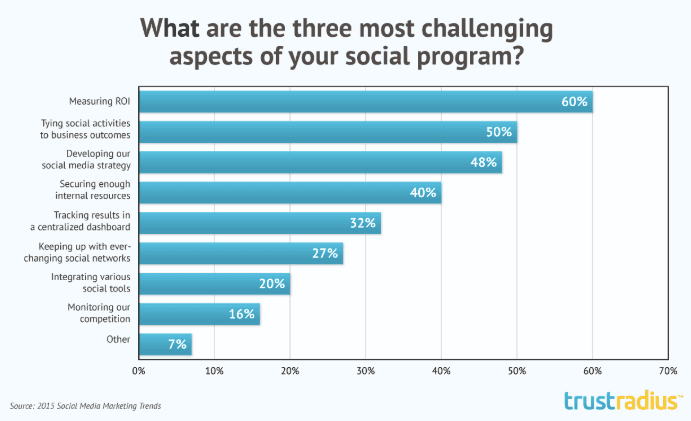How to Measure Your Social Media ROI
Here's how you calculate the ROI from your Social Media Management campaigns. 34% of marketers don't know how to do this. Use this tool, it's a lifesaver.
Updated November 7, 2024

Since the advent of social media in popular culture, with major players such as LinkedIn and Facebook providing a great platform for businesses to engage with new audiences, businesses have been afforded a great opportunity to gain a great return on investment (ROI) by adding social media to their marketing campaigns.
Despite this, 34% of marketers have stated that they were unsure of how to calculate the ROI on their social media marketing campaigns. A common question that is asked is, what is marketing ROI?
Social media marketing is the use of social media platforms and websites to promote a product or service. Although the terms e-marketing and digital marketing are still dominant in academia, social media marketing is becoming more popular for both practitioners and researchers.
What is ROI in Social Media Marketing?
Marketing ROI Definition: “Return on Marketing Investment is the contribution to profit that can be attributed to marketing, divided by the amount spent on a marketing campaign”. This is usually expressed as a percentage.
How to Measure Your Social Media Marketing Campaign ROI?
One of the first steps to measuring your ROI for your social media campaign would be to identify the objective of your marketing on social media.
If you are planning to raise the awareness of your brand, you should measure your Key-Performance Indicators (KPIs) as likes, shares, and impressions, whereas if you are measuring it in sales, you will need to view your ROI as a monetary figure, using your converted sales leads through social media as the main KPI.
Also, you should make sure that you set specific, actionable goals for your social media management. These goals should also be quantifiable, so you must apply them based on measurable actions. Some examples of these can be found below.
- Number of email list sign-ups during the campaign.
- Number of online form submissions during the campaign.
- Number of free trials set-up during the campaign.
- Number of customer purchases during the campaign.
- Number of downloads for your whitepaper or Ebook.
Because these goals are quantifiable, you will easily be able to measure whether or not your campaign is having the desired effect by tracking increases or decreases in these goals during your social media marketing campaign.
Pro tip: want to put all your ideas in one place? Get our social media strategy worksheet.
Problems and Benefits of Marketing ROI
In addition to the statistic originally mentioned, when pressed about the biggest challenge facing their social media programs, 60% of marketers have stated that measuring ROI was their biggest issue.
The importance of social media marketing cannot be understated, with a study by Forbes illustrating that representatives that also use social media outsell a large portion of their peers at 78%.
What Most Marketers do Wrong With Their ROI?
One big problem with marketers measuring their ROI is that despite the fact that social media marketing is an important tool for marketers, only 63% have stated that they regularly discuss ROI with business executives.
A large problem stems from marketers not involving their seniors in the process of measuring ROI, as the goals for ROI and the metrics that should be used are subjects that should be considered alongside senior management. Marketers should focus on informing the management of the different types of metrics and how they can be interpreted. Another problem with marketers and their ROI on social media boils down to customer perceptions of the brand. 56% of customers will unfollow a brand for poor online customer service, 51% will unfollow for irrelevant content and 43% will disappear if they see too many advertisements. It is important to treat your customers well, produce valuable non-clickbait content and not go crazy on the adverts.
Measuring Marketing ROI the Right Way
There are a number of methods for measuring your Marketing ROI correctly, and one of them involves assigning values to your KPIs.
- Lifetime value: How much money do your clients earn you on average?
- Lifetime value x Conversion Rate: Based on your conversion rates, how much is each social media visit worth? For example, if you convert at 10% and the lifetime value is $200, each visit is worth $20.
- Average Sale Value: What is the value of the average purchase through your website?
- PPC Valuation: What would you spend to get the same social media results through paid advertising?
If you are paying for advertising through social media, you will have to find your conversion rate for the generated leads. Then, figure out how much each customer pays you on average over their lifetime.
So, for example, if you pay $0.27 per click which is the average on Facebook and you get 1000 clicks, paying $270. Then, if you figure out that you convert at 10% and the average lifetime value of your customer is $100, your profit attributable to marketing is $10,000. Therefore you get the following equation to work out your Marketing ROI: $10,000 ÷ $270 = $37.037. $37.037 x 100 = 3703.70% Of course, if you do not pay for your advertising, your ROI on each sale would be higher. Whether or not you choose to pay for your social media campaign is going to be based on whether your internal marketing team will be able to consistently produce content that can connect with your audience.
Pay per click has the added benefit of pushing your content to the audience more forcefully. You should discuss your approach with your marketing team to get the best ROI for your investment.
There are also a number of campaign reporting tools that can help you, as a marketer to properly define and monitor your digital marketing KPIs. This, in turn, will help you to measure your social media marketing ROI.
FAQs
What are the different types of social media marketing?
The main types of social media marketing include - social networking (Facebook, Linkedin, Twitter, Google+), microblogging, photo sharing (Instagram, Snapchat, Pinterest) and video sharing (YouTube, Facebook, Snapchat, TikTok).
What is meant by social media marketing?
Social media marketing is the use of social media platforms and websites to promote a product or service. Although the terms e-marketing and digital marketing are still dominant in academia, social media marketing is becoming more popular for both practitioners and researchers.
What skills are needed for social media marketing?
The ten essential skills that every social media manager and marketer need are strategy planning, tactics and execution, community management, content marketing, SEO, writing, creativity, and knowledge of the latest digital marketing trends.
What is ROI in social media marketing?
Return on Marketing Investment is the contribution to profit that can be attributed to marketing, divided by the amount spent on a marketing campaign”. This is usually expressed as a percentage.
How do you calculate social media ROI?
If you are planning to raise the awareness of your brand, you should measure your Key-Performance Indicators (KPIs) as likes, shares, and impressions, whereas if you are measuring it in sales, you will need to view your ROI as a monetary figure, using your converted sales leads through social media as the main KPI.





![The Ultimate Guide to Social Media Marketing: Tips, Strategies & Tools [{year}]](https://entail.mayple.com/en-assets/mayple/fit-in/280x280/637235283d1059598965dfd0_socialmediamarketing1_a8f42d67f17ada7c19a1fdf4471a18d7_2000-1699775614609.jpg)
